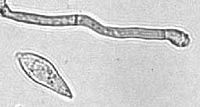
Photo from wikipedia
The Vietnamese rice landrace Tetep is known world-wide for its exceptional broad-spectrum and durable resistance to blast disease caused by Pyricularia oryzae. In present study, we report on identification and… Click to show full abstract
The Vietnamese rice landrace Tetep is known world-wide for its exceptional broad-spectrum and durable resistance to blast disease caused by Pyricularia oryzae. In present study, we report on identification and mapping of a new blast resistance gene Pi-67 from a doubled haploid line TDH251 that derives its resistance from Tetep. Using a multipronged mapping strategy combining bulked segregant analysis, recessive class approach and conventional pathotype analysis, the resistance gene was fine mapped to a 0.4 cM interval flanked by markers YL87/155 and RRS8 near the centromere of chromosome 12. By projecting the sequences of flanking markers on the reference sequence of cv. Nipponbare, a 2.03 Mb region extending from position 10.60 to 12.63 Mb near the centromere of rice chromosome 12 was delineated as the region of blast resistance locus. A total of 106 predicted genes were identified in Pi-67 region by surveying the equivalent genomic region of cv. Nipponbare in Rice Annotation Project Database (RAP-DB) (http://rapdbbeta.dna.affrc.go.jp). Out of these, Os12g0281600 encoding nucleotide-binding site and leucine-rich repeat (NBS–LRR) protein was short listed as a potential candidate for the blast resistance gene identified from TDH251. Based on conventional pathotype analysis and allele sequencing, Pi-67(t) could be differentiated from other two blast resistance genes Pi19 and Pi-42(t) that occupy syntenic position on chromosome 12. The physical localization of Pi-67 and identification of a NBS–LRR gene Os12g0281600 as a potential R-gene candidate has set the stage for cloning and functional characterization of this resistance gene.
Journal Title: Euphytica
Year Published: 2018
Link to full text (if available)
Share on Social Media: Sign Up to like & get
recommendations!